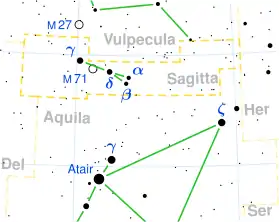Gamma Sagittae
Gamma Sagittae, Latinized from γ Sagittae, is the brightest star in northern constellation of Sagitta. A single star,[14] it is visible to the naked eye with an apparent visual magnitude of +3.47.[2] Based upon an annual parallax shift of 12.62 mas as seen from Earth, it is located about 258 light years from the Sun. It is moving closer to the Sun with a radial velocity of −34 km/s.[6]
 | |
| Observation data Epoch J2000.0 Equinox J2000.0 (ICRS) | |
|---|---|
| Constellation | Sagitta |
| Right ascension | 19h 58m 45.42863s[1] |
| Declination | +19° 29′ 31.7281″[1] |
| Apparent magnitude (V) | +3.47[2] |
| Characteristics | |
| Evolutionary stage | Red Giant |
| Spectral type | M0 III[3][4][5] |
| U−B color index | +1.93[2] |
| B−V color index | +1.57[2] |
| Astrometry | |
| Radial velocity (Rv) | −34.0±0.2[6] km/s |
| Proper motion (μ) | RA: 66.21±0.14[1] mas/yr Dec.: 22.22±0.12[1] mas/yr |
| Parallax (π) | 12.62 ± 0.18[1] mas |
| Distance | 258 ± 4 ly (79 ± 1 pc) |
| Absolute magnitude (MV) | −1.11[7] |
| Details | |
| Mass | 0.88+0.05 −0.02 M☉[8] 0.9±0.2 M☉[9] 1.3±0.4 M☉[10] 1.37±2.00 M☉[11] 1.77[4] M☉ |
| Radius | 55.13±3.29[12] R☉ |
| Luminosity (bolometric) | 562±75[12] L☉ |
| Surface gravity (log g) | 1.71[13] cgs |
| Temperature | 3,862±40[4] K |
| Metallicity [Fe/H] | −0.14[12] dex |
| Age | 2.35[4] Gyr |
| Other designations | |
| Database references | |
| SIMBAD | data |
This is a red giant star with a stellar classification of M0 III.[10][15] It is most likely (94% chance) on the red-giant branch of its evolutionary lifespan, fusing hydrogen along a shell to generate energy.[8][11] The star is around 2.35[4] billion years old with roughly 55[12] times the Sun's radius. Mass estimates range from 0.9[9][8] to 1.8[4] times the mass of the Sun. It is radiating about 562[12] times the Sun's luminosity from its enlarged photosphere at an effective temperature of 3,862 K.[4]
Naming
In Chinese, 左旗 (Zuǒ Qí), meaning Left Flag, refers to an asterism consisting of γ Sagittae, α Sagittae, β Sagittae, δ Sagittae, ζ Sagittae, 13 Sagittae, 11 Sagittae, 14 Sagittae and ρ Aquilae. Consequently, the Chinese name for γ Sagittae itself is 左旗五 (Zuǒ Qí wǔ, English: the Fifth Star of Left Flag).[16]
References
- van Leeuwen, F. (2007). "Validation of the New Hipparcos Reduction". Astronomy and Astrophysics. 474 (2): 653–64. arXiv:0708.1752. Bibcode:2007A&A...474..653V. doi:10.1051/0004-6361:20078357. S2CID 18759600.
- Ducati, J. R. (2002). "VizieR Online Data Catalog: Catalogue of Stellar Photometry in Johnson's 11-color system". CDS/ADC Collection of Electronic Catalogues. 2237. Bibcode:2002yCat.2237....0D.
- Keenan, Philip C.; McNeil, Raymond C. (1989). "The Perkins catalog of revised MK types for the cooler stars". Astrophysical Journal Supplement Series. 71: 245. Bibcode:1989ApJS...71..245K. doi:10.1086/191373.
- Luck, R. Earle (2015). "Abundances in the Local Region. I. G and K Giants". Astronomical Journal. 150 (3). 88. arXiv:1507.01466. Bibcode:2015AJ....150...88L. doi:10.1088/0004-6256/150/3/88. S2CID 118505114.
- Skiff, B. A. (2014). "VizieR Online Data Catalog: Catalogue of Stellar Spectral Classifications (Skiff, 2009-2016)". VizieR On-line Data Catalog: B/Mk. Originally Published in: Lowell Observatory (October 2014). 1. Bibcode:2014yCat....1.2023S.
- Famaey, B.; Jorissen, A.; Luri, X.; Mayor, M.; Udry, S.; Dejonghe, H.; Turon, C. (2005). "Local kinematics of K and M giants from CORAVEL/Hipparcos/Tycho-2 data. Revisiting the concept of superclusters". Astronomy and Astrophysics. 430: 165. arXiv:astro-ph/0409579. Bibcode:2005A&A...430..165F. doi:10.1051/0004-6361:20041272. S2CID 17804304.
- Setiawan, J.; et al. (July 2004), "Precise radial velocity measurements of G and K giants. Multiple systems and variability trend along the Red Giant Branch", Astronomy and Astrophysics, 421: 241–254, Bibcode:2004A&A...421..241S, doi:10.1051/0004-6361:20041042-1.
- Stock, Stephan; Reffert, Sabine; Quirrenbach, Andreas; Hauschildt, P. (2018). "Precise radial velocities of giant stars. X. Bayesian stellar parameters and evolutionary stages for 372 giant stars from the Lick planet search". Astronomy and Astrophysics. 616: A33. arXiv:1805.04094. Bibcode:2018A&A...616A..33S. doi:10.1051/0004-6361/201833111. S2CID 119361866.
- Neilson, Hilding R.; Lester, John B. (2008). "Determining parameters of cool giant stars by modeling spectrophotometric and interferometric observations using the SAtlas program". Astronomy and Astrophysics. 490 (2): 807–10. arXiv:0809.1875. Bibcode:2008A&A...490..807N. doi:10.1051/0004-6361:200810627. S2CID 1586125.
- Wittkowski, M.; Hummel, C. A.; Aufdenberg, J. P.; Roccatagliata, V. (December 2006), "Tests of stellar model atmospheres by optical interferometry. III. NPOI and VINCI interferometry of the M0 giant γ Sagittae covering 0.5-2.2 μm", Astronomy and Astrophysics, 460 (3): 843–853, arXiv:astro-ph/0610149, Bibcode:2006A&A...460..843W, doi:10.1051/0004-6361:20065853, S2CID 15437314.
- Reffert, Sabine; Bergmann, Christoph; Quirrenbach, Andreas; Trifonov, Trifon; Künstler, Andreas (2015). "Precise radial velocities of giant stars. VII. Occurrence rate of giant extrasolar planets as a function of mass and metallicity". Astronomy & Astrophysics. 574: A116. arXiv:1412.4634. Bibcode:2015A&A...574A.116R. doi:10.1051/0004-6361/201322360. hdl:10722/215277. S2CID 59334290.
- Piau, L.; Kervella, P.; Dib, S.; Hauschildt, P. (2011). "Surface convection and red-giant radius measurements". Astronomy and Astrophysics. 526: 12. arXiv:1010.3649. Bibcode:2011A&A...526A.100P. doi:10.1051/0004-6361/201014442. S2CID 118533297. A100.
- Bluhm, P.; Jones, M. I.; Vanzi, L.; Soto, M. G.; Vos, J.; Wittenmyer, R. A.; Drass, H.; Jenkins, J. S.; Olivares, F.; Mennickent, R. E.; Vučković, M.; Rojo, P.; Melo, C. H. F. (2016). "New spectroscopic binary companions of giant stars and updated metallicity distribution for binary systems". Astronomy & Astrophysics. 593: A133. arXiv:1608.08260. Bibcode:2016A&A...593A.133B. doi:10.1051/0004-6361/201628459. S2CID 56087624.
- Eggleton, P. P.; Tokovinin, A. A. (September 2008), "A catalogue of multiplicity among bright stellar systems", Monthly Notices of the Royal Astronomical Society, 389 (2): 869–879, arXiv:0806.2878, Bibcode:2008MNRAS.389..869E, doi:10.1111/j.1365-2966.2008.13596.x, S2CID 14878976.
- Strassmeier, K. G.; Ilyin, I.; Weber, M. (2018). "PEPSI deep spectra. II. Gaia benchmark stars and other M-K standards". Astronomy and Astrophysics. 612: A45. arXiv:1712.06967. Bibcode:2018A&A...612A..45S. doi:10.1051/0004-6361/201731633. S2CID 119244142.
- (in Chinese) AEEA (Activities of Exhibition and Education in Astronomy) 天文教育資訊網 2006 年 7 月 3 日
External links
- Kaler, James B. "GAMMA SGE (Gamma Sagittae)". STARS. University of Illinois. Retrieved 2017-11-30.